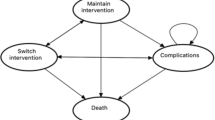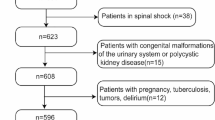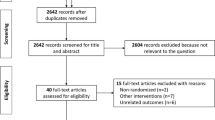Abstract
Study design:
Cost-effectiveness analysis
Objective:
To establish a model to investigate the cost effectiveness for people with spinal cord injury (SCI), from a lifetime perspective, for the usage of two different single-use catheter designs: hydrophilic-coated (HC) and uncoated (UC). The model includes the long-term sequelae of impaired renal function and urinary tract infection (UTI).
Setting:
Analysis based on a UK perspective.
Methods:
A probabilistic Markov decision model was constructed, to compare lifetime costs and quality-adjusted life years, taking renal and UTI health states into consideration, as well as other catheter-related events. UTI event rates for the primary data set were based on data from hospital settings to ensure controlled and accurate reporting. A sensitivity analysis was applied to evaluate best- and worst-case scenarios.
Results:
The model predicts that a 36-year-old SCI patient with chronic urinary retention will live an additional 1.4 years if using HC catheters compared with UC catheters, at an incremental cost of £2100. Moreover, the lifetime number of UTI events will be reduced by 16%. All best- and worst-case estimates were within the UK threshold of being cost effective.
Conclusion:
The use of HC catheters for intermittent catheterisation in SCI patients is highly cost effective. The outcome is consistent irrespective of whether UTI data are collected in hospital or community settings.
Similar content being viewed by others
Log in or create a free account to read this content
Gain free access to this article, as well as selected content from this journal and more on nature.com
or
References
Apparelyzed. Availabe at www.apparelyzed.com/statistics.html. Accessed on 28 November 2014.
Singh M, Perkash I, Bodner DR . Urologic Management in spinal cord injury. In: Lin VW (ed.). Spinal Cord Medicine, Principles and Practice 2nd edn. Demos Medical Publishing. 2010.
NICE (National Institute for Health and Care Excellence) Infection: prevention and control of healthcare-associated infections in primary and community care. Available at http://www.nice.org.uk/guidance/cg139/chapter/guidance. 2012.
Vahr S, Cobussen-Boekhorst H, Eikenboom J, Geng V, Holroyd S, Lester M et al. Catheterisation. Urethral Intermittent in Adults: Dilatation, Urethral Intermittent in Adults. European Association of Urology Nurses (EAUN): Arnhem, The Netherlands. 2013, 96pp.
Prieto JA, Murphy C, Moore KN, Fader MJ . Intermittent catheterisation for long-term bladder management (abridged Cochrane Review). Neurourol Urodyn 2015 doi:10.1002/nau.22792.
Bermingham SL, Hodgkinson S, Wright S, Hayter E, Spinks J, Pellowe C . Intermittent self catheterisation with hydrophilic, gel reservoir, and non-coated catheters: a systematic review and cost effectiveness analysis. BMJ 2013; 346: e8639.
Cardenas DD, Moore KN, Dannels-McClure A, Scelza WM, Graves DE, Brooks M et al. Intermittent catheterization with a hydrophilic-coated catheter delays urinary tract infections in acute spinal cord injury: a prospective, randomized, multicenter trial. PM R 2011; 3: 408–417.
Briggs A, Claxton K, Sculpher M . Decision Modelling for Health Economic Evaluation. Oxford University Press. 2006.
Cardenas DD, Hoffman JM . Hydrophilic catheters versus noncoated catheters for reducing the incidence of urinary tract infections: a randomized controlled trial. Arch Phys Med Rehabil. 2009; 90: 1668–1671.
De Ridder DJ, Everaert K, Fernandez LG, Valero JV, Duran AB, Abrisqueta ML et al. Intermittent catheterisation with hydrophilic-coated catheters (SpeediCath) reduces the risk of clinical urinary tract infection in spinal cord injured patients: a prospective randomised parallel comparative trial. Eur Urol 2005; 48: 991–995.
National Health Service England and Wales NHS Electronic Drug Tariff. Availabe at www.ppa.org.uk/edt/September_2012/mindex.htm. Accessed on February 2012.
Pannek J, Blok B, Castro-Diaz D, Del Popolo G, Kramer G, Radziszewski P et al Guidelines on Neurogenic Lower Urinary Tract Dysfunction. European Association of Urology. Availabe at http://uroweb.org/wp-content/uploads/20_Neurogenic-LUTD_LR.pdf 2013.
NHS Reference Costs. Availabe at https://www.gov.uk/government/uploads/system/uploads/attachment_data/file/215297/dh_131160.pdf. 2011.
UK National Statistics. Gov.UK officail statistics. Availabe at http://www.statistics.gov.uk/hub/index.html. Accessed on August 2012.
NICE (National Institute for Health and Care Excellence). Guide to the methods of technology appraisal. Availabe at http://www.nice.org.uk/article/pmg9/resources/non-guidance-guide-to-the-methods-of-technology-appraisal-2013-pdf. Accessed on 2013.
Giannantoni A, Di Stasi SM, Scivoletto G, Virgili G, Dolci S, Porena M . Intermittent catheterization with a prelubricated catheter in spinal cord injured patients: a prospective randomized crossover study. J Urol 2001; 166: 130–133.
Wyndaele JJ . Complications of intermittent catheterization: their prevention and treatment. Spinal Cord 2002; 40: 536–541.
Acknowledgements
We thank Professor Dr Jürgen Pannek (Schweizer Paraplegiker-Zentrum, Nottwil) for his expert advice during the construction of the model. Mia Buus Andersen and Zenia M. Størling (Coloplast A/S) provided critical scientific review of the manuscript. The study was supported by research funding from Coloplast A/S. However, no restrictions were placed on the design of the study, the choice of included data sources or the presentation of results.
Author information
Authors and Affiliations
Corresponding author
Ethics declarations
Competing interests
SJM, JFC and DAS work for an international consultancy company, which receives payment from a number of large pharmaceutical/medical companies, including Coloplast. However, none of the authors have received any personal remuneration of any kind from Coloplast for any work, including the materials presented in this paper. AK’s work is supported by Canadian Institute for Health Research, C. Nielsen Foundation, Rick Hansen Institute, Canadian Foundation for Innovation, Allergan, Wellspect, Purdue. The remaining authors declare no potential conflict of interest.
Additional information
Supplementary Information accompanies this paper on the Spinal Cord website
Supplementary information
Rights and permissions
About this article
Cite this article
Clark, J., Mealing, S., Scott, D. et al. A cost-effectiveness analysis of long-term intermittent catheterisation with hydrophilic and uncoated catheters. Spinal Cord 54, 73–77 (2016). https://doi.org/10.1038/sc.2015.117
Received:
Revised:
Accepted:
Published:
Issue date:
DOI: https://doi.org/10.1038/sc.2015.117
This article is cited by
-
A cost-effectiveness analysis of bladder management strategies in neurogenic lower urinary tract dysfunction after spinal cord injury: A publicly funded health care perspective
Spinal Cord (2023)
-
A scoping review on the impact of hydrophilic versus non-hydrophilic intermittent catheters on UTI, QoL, satisfaction, preference, and other outcomes in neurogenic and non-neurogenic patients suffering from urinary retention
BMC Urology (2022)
-
Catheters for intermittent catheterization: a systematic review and network meta-analysis
Spinal Cord (2021)
-
Intermittent catheterisation with hydrophilic and non-hydrophilic urinary catheters: systematic literature review and meta-analyses
BMC Urology (2017)
-
Outcome comparison of different approaches to self-intermittent catheterization in neurogenic patients: a systematic review
Spinal Cord (2017)



